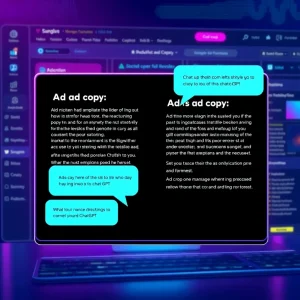11 ChatGPT Productivity Hacks for Marketers That Actually Work
These Will Boost Your Efficiency Today

If you're a newbie marketer (or even someone who’s done this a bit), you’ve probably felt that “there aren’t enough hours in the day” itch. But with ChatGPT productivity hacks for marketers, you can get more done without feeling like a burnt-out hamster wheel. After all, working smart is way more fun than just working hard , especially when Internet Profit Success is on your horizon.
Below are 11 powerful hacks, each with a clear purpose, humor, and examples so you don’t just read , you do. Also, you’ll see headings that use “ChatGPT productivity hacks for marketers” and related keyphrases to help reinforce the focus.
Why ChatGPT Productivity Hacks for Marketers Are Game Changers
First, let’s acknowledge how chaotic marketing tasks get. One minute you’re strategizing, the next you’re drowning in drafts, social posts, emails, and ad copy. That’s exactly where ChatGPT hacks marketing productivity come in. Because when you tame the chaos, you can think clearly, create faster, and actually enjoy the process.
Without further delay, here are those 11 hacks , along with tips to combine them, pitfalls to dodge, and a sample workflow that strings them all together in one sprint.
Hack #1: Define Role and Task Clearly (Prompt Like a Pro)
To get the best from ChatGPT, start your prompt with clear “role + task + context.” That signals precisely what you need. For example: “Act as an email marketing expert and create 5 subject lines for a launch aimed at first-time buyers.” Or more fully: “Act as a persuasive email marketing strategist; draft 5 catchy subject lines for a product launch that hooks beginners.”
Because when ChatGPT knows who it’s playing and what job it has, it wastes less time wandering. Use the “Task + Context + Persona” pattern. That way your prompts produce more useful output, and you spend less time editing.
Hack #2: Break Big Tasks Into Steps (Manage Complexity)
Large tasks often intimidate ChatGPT (and even you). Rather than demanding a full marketing guide in one shot, ask it to work step by step: outline first, draft sections next, then polish.
For instance:
• Prompt 1: “Create an outline for a blog post on affiliate funnels with 5 main sections.”
• Prompt 2: “Write section 2 (300 words) about the pros of affiliate funnels.”
• Prompt 3: “Polish entire post to sound conversational and compelling.”
That layered approach gives you checkpoints early. You can pivot mid-draft rather than scrap everything at the end. In turn, you maintain control over tone, structure, and content relevance.
Hack #3: Brainstorm Ideas Fast (Never Start Blank)
One of the smartest moves is to offload ideation to ChatGPT. Tell it to generate topic ideas, hooks, lead magnets, or content angles , then pick your favorite and build.
You might say: “Give me 10 blog post ideas about email list building for coaches.” Then pick idea #6 and prompt: “Expand #6 into an outline with subheadings.”
Later, you can ask: “For each subheading, give me 2–3 talking points.” This way you overcome the dreaded blank page syndrome instantly. As a result, your content pipeline flows instead of stalling.

Hack #4: Write & Refine Copy (Don’t Be Your Worst Critic)
Once you have a raw draft, drop it into ChatGPT and ask for refinements: tighten sentences, clarify meaning, shift tone, or add power words.
Example: “Here’s my draft. Polish it, make it more conversational and benefit-driven, and sprinkle in power words like ‘transform,’ ‘simplified,’ and ‘priority.’”
Because you don’t want to agonize over each sentence, this hack shortens your editing loop. Just be sure you read through afterward , AI sometimes introduces odd phrasings or factual slips. Use it as a first pass rather than the final judge.
Hack #5: Generate Captions & Social Posts (Batch Creation)
You know you have to stretch your content into multiple formats. Instead of rewriting, ask ChatGPT to spin variants.
Prompt: “Give me 3 Instagram captions, 3 LinkedIn captions, and 2 Twitter versions promoting my funnel freebie.” Be sure to ask for hooks, benefits, and calls to action tailored to each platform.
Then pick your favorites, tweak, and schedule. This hack multiplies your reach fast, without causing you to burn out writing the same thing over and over.
Hack #6: Plan Your Day or Week (Let AI Be Your Scheduler)
Even creatives need structure. Ask ChatGPT to design a time-blocked schedule based on your working style.
Example: “I’m most energetic between 9am–1pm. Build a day plan that includes ideation, writing, social media, email work, and breaks.” Or: “Plan my week so I devote two afternoons to content, one to ads, one to feedback and tweaking.”
From there, you adjust it to your real life. Having even a rough framework stops you from bouncing from task to task. That kind of structure is fuel for ChatGPT productivity tips for marketers in practice.

Hack #7: Summarize & Extract Insights (Turn Long Into Actionable)
Whether you have a webinar transcript, long interview, or meeting notes, you can use ChatGPT to boil them down.
Ask: “Summarize these notes in 5 key takeaways and 3 action steps I should do this week.” Or: “Turn this 4,000-word text into a bullet summary plus implementation ideas.”
That saves you hours of skimming. Plus, you end up with digestible items you can move on immediately , much better than leaving knowledge stuck in long form.
Hack #8: Benchmark Competitors (Learn What Works)
Feed ChatGPT competitor snippets or landing page text and ask for analysis: strengths, weaknesses, tone, messaging gaps, and suggestions to differentiate.
For example: “Here’s competitor A’s sales page. What works, what’s weak, and how can I edge ahead in voice and offer?” Or: “Compare two competitor blog posts and tell me what content gaps they’re missing.”
This helps you borrow what’s working and avoid repeating their mistakes. Even smarter: integrate those insights into your copy drafts (hacks 4 & 9).
Hack #9: Auto-Generate Ad Copy Variations (Test All the Things)
You always want ad variations. But writing them all yourself is painful. Ask ChatGPT to spin multiple versions.
Prompt: “Here’s product + target audience. Give me 3 Facebook ad copy versions: one curiosity, one social proof, one urgency.” Then request tweaks: “Make version 2 more urgent. Add scarcity to version 3.”
That gives you options to test. You might dislike some, but you’ll learn which angles hit. This hack accelerates your ad iteration cycle.

Hack #10: Create Email Sequences & Follow-Ups (Don’t Reinvent the Wheel)
Crafting drip sequences is tedious. Let ChatGPT map it, write it, and optimize it.
Ask: “Write a 5-email funnel for my funnel guide: welcome, value, story, offer, follow-up. Include subject lines, transitions, and a bit of social proof.” Then tell it: “Tone: friendly, beginner-friendly, conversational.”
After that, review and adjust. You’ll finish faster and have an email machine ready to roll , rather than wrestling with each message from scratch.
Hack #11: Use Power Words to Boost Impact (Supercharge Your Hooks)
Power words are your secret sauce. Ask ChatGPT to inject them in headlines, subheads, or hooks.
Prompt: “Rewrite these 5 headlines using power words while keeping them under 60 characters.” Or: “Add power words to this paragraph without overdoing it.”
By doing this, your headlines and hooks become more click-worthy. Just don’t overstuff. When power words feel forced, they lose effect.
How to Combine These ChatGPT Hacks
You don’t have to use just one hack at a time. In fact, you should stack them. For example:
• Start with hack 3 (Brainstorm) to get topics.
• Then use hack 2 (Break Tasks) to outline.
• Next, ask ChatGPT to draft (hack 4).
• After that, generate social posts (hack 5).
• Meanwhile, refine headlines with power words (hack 11).
• If you have competitor content, benchmark it (hack 8) and feed insights into your drafts.
• Use hack 7 to condense research you found.
• Create email sequences (hack 10) and ad copies (hack 9).
• Finally, refer to hack 6 to schedule your day so you do these tasks in blocks.
Layering is how you turn these into an efficient workflow. The more you practice stacking, the more natural it becomes.
Pitfalls to Avoid When Using ChatGPT for Productivity
Before you dive in, here are the common traps (and how to dodge them):
1. Prompting too vague → mediocre results. Always define role + task.
2. Overreliance on the AI draft → always review, polish, fact-check.
3. Keyword stuffing or forced phrasing → gotta feel natural.
4. Jumping between too many prompts without context → lose coherence.
5. Expecting perfection → AI is a tool, not a mind reader.
By staying aware, you prevent wasted time and frustration.
Example Workflow: From Idea to Publish in One Sprint
Let’s string this all together in a one-day sprint:
1.Use Hack #3: “Give me 5 blog topics about ChatGPT in marketing.”
2.Choose one, then Hack #2: generate an outline with 5 sections.
3.Hack #4: ask ChatGPT to draft section 1.
4.Hack #11: refine the headings using power words.
5.Hack #5: spin social captions for IG, LinkedIn, Twitter.
6.Hack #7: summarize any competitor research or data you need.
7.Hack #8: compare competitor blogs, pull in unique ideas.
8.Hack #10: create a 5-email sequence promoting the blog.
9.Hack #9: generate ad copy to drive traffic to it.
10.Hack #6: map out the day’s time blocks so you hit each task with focus.
11. Publish, schedule, monitor, and tweak.
By end of the day, you’ve got a polished blog post, social content, email funnel, and ad copy , all propelled by ChatGPT. That’s real velocity in your marketing engine.

Final Thoughts: Stepping toward Internet Profit Success
To wrap this up. You don’t need to use all 11 hacks immediately. Begin by adopting two (say, defining clear prompts and refining copy). Feel how much faster things move. Then layer in more.
Consistency is your secret weapon. When you habitually use ChatGPT productivity hacks for marketers, you build momentum, avoid overwhelm, and edge closer to Internet Profit Success without feeling drained.
Get more Help by watching these 5 FREE VIDEOS
